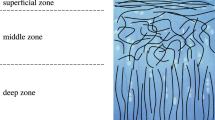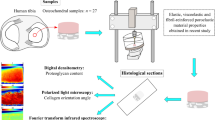Abstract
The remarkable compressive strength of articular cartilage arises from the mechanical interactions between the tension-resisting collagen fibrils and swelling proteoglycan proteins within the tissue. These interactions are facilitated by a significant level of interconnectivity between neighbouring collagen fibrils within the extracellular matrix. A reduction in interconnectivity is suspected to occur during the early stages of osteoarthritic degeneration. However, the relative contribution of these interconnections towards the bulk mechanical properties of articular cartilage has remained an open question. In this study, we present a simple 2D fibre network model which explicitly represents the microstructure of articular cartilage as collection of discrete nodes and linear springs. The transverse stiffness and swelling properties of this fibre network are studied, and a semi-analytic relationship which relates these two macroscopic properties via microscopic interconnectivity is derived. By comparing this derived expression to previously published experimental data, we show that although a reduction in network interconnectivity accounts for some of the observed changes in the mechanical properties of articular cartilage as degeneration occurs, a decrease in matrix interconnectivity alone do not provide a full account of this process.












Similar content being viewed by others
References
Broom ND (1984a) Further insights into the structural principles governing the function of articular cartilage. Journal of anatomy 139(Pt 2):275
Broom Neil D (1984) The altered biomechanical state of human femoral head osteoarthritic articular cartilage. Arthritis & Rheumatology 27(9):1028–1039
Broom Neil D, Flachsmann René (2003) Physical indicators of cartilage health: the relevance of compliance, thickness, swelling and fibrillar texture. Journal of Anatomy 202(6):481–494
Broom Neil D, Marra Denis L (1985) New structural concepts of articular cartilage demonstrated with a physical model. Connective tissue research 14(1):1–8
Broom Neil D, Marra Denis L (1986) Ultrastructural evidence for fibril-to-fibril associations in articular cartilage and their functional implication. Journal of anatomy 146:185
Chahine Nadeen O, Chen Faye H, Hung Clark T, Ateshian Gerard A (2005) Direct measurement of osmotic pressure of glycosaminoglycan solutions by membrane osmometry at room temperature. Biophysical journal 89(3):1543–1550
Chen Ying-chun, Chen Minsi, Gaffney Eamonn A, Brown Cameron P (2017) Effect of crosslinking in cartilage-like collagen microstructures. Journal of the mechanical behavior of biomedical materials 66:138–143
Dhume, Rohit Y., Barocas, Victor H.: Fiber-network modeling in biomechanics: Theoretical and analytical approaches. In: Biomechanics: trends in modeling and simulation. Springer, pp 271–307 (2017)
Fox Alice JS, Bedi Asheesh, Rodeo Scott A (2009) The basic science of articular cartilage: structure, composition, and function. Sports health 1(6):461–468
Halloran JP, Sibole S, Van Donkelaar CC, Van Turnhout MC, Oomens CWJ, Weiss JA, Guilak F, Erdemir A (2012) Multiscale mechanics of articular cartilage: potentials and challenges of coupling musculoskeletal, joint, and microscale computational models. Annals of biomedical engineering 40(11):2456–2474
Julkunen Petro, Kiviranta Panu, Wilson Wouter, Jurvelin Jukka S, Korhonen Rami K (2007) Characterization of articular cartilage by combining microscopic analysis with a fibril-reinforced finite-element model. Journal of biomechanics 40(8):1862–1870
Julkunen Petro, Wilson Wouter, Isaksson Hanna, Jurvelin Jukka S, Herzog Walter, Korhonen Rami K (2013) A review of the combination of experimental measurements and fibril-reinforced modeling for investigation of articular cartilage and chondrocyte response to loading. Computational and mathematical methods in medicine, 2013
Klika Vaclav, Gaffney Eamonn A, Chen Ying-Chun, Brown Cameron P (2016) An overview of multiphase cartilage mechanical modelling and its role in understanding function and pathology. journal of the mechanical behavior of biomedical materials 62:139–157
LeRoux Michelle A, Arokoski Jari, Vail T Parker, Guilak Farshid, Hyttinen Mika M, Kiviranta Ilkka, Setton Lori A (2000) Simultaneous changes in the mechanical properties, quantitative collagen organization, and proteoglycan concentration of articular cartilage following canine meniscectomy. Journal of Orthopaedic Research 18(3):383–392
Nickien Mieke, Thambyah Ashvin, Broom Neil (2013) How changes in fibril-level organization correlate with the macrolevel behavior of articular cartilage. Wiley Interdisciplinary Reviews: Systems Biology and Medicine 5(4):495–509
Nickien Mieke, Thambyah Ashvin, Broom Neil D (2017) How a decreased fibrillar interconnectivity influences stiffness and swelling properties during early cartilage degeneration. Journal of the Mechanical Behavior of Biomedical Materials 75:390–398
Pratta MichaelA, Yao Wenqing, Decicco Carl, Tortorella Micky D, Liu Riu-Qin, Copeland Robert A, Magolda Ronald, Newton Robert C, Trzaskos James M, Arner Elizabeth C (2003) Aggrecan protects cartilage collagen from proteolytic cleavage. Journal of Biological Chemistry 278(46):45539–45545
Shen Zhilei L, Dodge Mohammad Reza, Kahn Harold, Ballarini Roberto, Eppell Steven J (2008) Stress-strain experiments on individual collagen fibrils. Biophysical Journal 95(8):3956–3963
Shepherd DET, Seedhom BB (1997) A technique for measuring the compressive modulus of articular cartilage under physiological loading rates with preliminary results. Proceedings of the Institution of Mechanical Engineers, Part H: Journal of Engineering in Medicine 211(2):155–165
Silverberg JesseL, Barrett Aliyah R, Das Moumita, Petersen Poul B, Bonassar Lawrence J, Cohen Itai (2014) Structure-function relations and rigidity percolation in the shear properties of articular cartilage. Biophysical journal 107(7):1721–1730
Author information
Authors and Affiliations
Corresponding author
Ethics declarations
Conflict of interest
The authors declare that they have no conflict of interest.
Additional information
Publisher's Note
Springer Nature remains neutral with regard to jurisdictional claims in published maps and institutional affiliations.
Electronic supplementary material
Below is the link to the electronic supplementary material.
Appendix: Derivation of non-affinity coefficients
Appendix: Derivation of non-affinity coefficients
Consider a 3D network composed of \(N_{x} \times N_{y} \times N_{z}\) nodes, where \(N_{x}\), \(N_{y}\) and \(N_{z}\) are the number of nodes in the x (transverse), y (radial) and z (out-of-plane) direction, respectively. We will assume that the nodes are regularly ordered in a repeating cubic lattice; nodes in the x, y and z direction are equally separated from one another by a distance of \(L_{x}\), \(L_{y}\) and \(L_{z}\) \(\mu \)m, respectively. We shall further assume that nodes immediately adjacent to one another are connected by springs of stiffness \(k_{x}\) \(\upmu \hbox {N} \times \hbox {strain}^{-1}\) (not \(\upmu \)N \(\times \) displacement\(^{-1}\)) if they are orientated in the x direction, \(k_{y}\) \(\upmu \hbox {N} \times \hbox {strain}^{-1}\) if they are orientated in the y direction, or \(k_{z}\) \(\upmu \hbox {N} \times \hbox {strain}^{-1}\) if they are orientated in the z direction. For the purposes of visualisation, this hypothetical network is schematically shown in Fig. 13.
To derive expressions for the transverse stiffness and swelling potential of this network, we will utilise two results. First, given the regular cubic configuration of the network, the network will deform affinely during the mechanical tests being considered. Hence, the entire network can be treated as an effective spring composed of smaller springs in series and parallel. Second, given that the stiffness of each spring is in units \(\upmu \hbox {N} \times \hbox {strain}^{-1}\), we can deduce that the total stiffness of n identical springs of stiffness k \(\upmu \hbox {N} \times \hbox {strain}^{-1}\) in series and parallel is k \(\upmu \hbox {N} \times \hbox {strain}^{-1}\) and \(n\times k\) \(\upmu \hbox {N} \times \hbox {strain}^{-1}\), respectively. Consequently, the bulk effective spring constant K (i.e. the force exerted by the entire network per unit strain) associated with this regular cubic network in each direction is:
These bulk spring constants give the force exerted by the network per unit strain in a given direction. To determine the transverse Young’s modulus associated with the network \(E^{\text {Affine}}_\mathrm{T}\), we must divide these bulk spring constants by the cross-sectional surface area of the network perpendicular to the x direction \(A_{x}\):
To account for non-affine interactions, we shall modify Eq. (29) by introducing the transverse non-affinity coefficient \(\alpha _\mathrm{T}\) such that:
where \(K_{x}\) is the bulk spring constant associated with an equivalent non-affine network.
Hence, the transverse Young’s modulus of a network which deforms non-affinely \(E_\mathrm{T}\) can be written as:
Suppose that the bulk transverse spring constant of a 2D fibre network is computed to be \(K^{\text {2D}}_\mathrm{T}\) \(\upmu \hbox {N} \times \hbox {strain}^{-1}\). If we assume that this 2D bulk spring constant is equal to the bulk spring stiffness of an equivalent 3D network averaged over each layer of nodes in the z direction (i.e. \(K^{\text {2D}}_\mathrm{T}\) = \(K_\mathrm{T}\)/\(N_{z}\)), then the non-affinity coefficient \(\alpha \) can be evaluated from this arbitrary 2D network by rearranging Eq. (33) for \(\alpha _\mathrm{T}\):
Furthermore, by considering the limit \(N_{z} \rightarrow \infty \) (i.e. the network is semi-infinite in the out-of-plane direction), Eq. (34) become:
From this expression, the transverse Young’s modulus of a 2D network which deforms non-affinely may be calculated.
With regard to the free swelling test, we can write both the initial \(V_{0}\) and the post-swelling volume V of the network as:
where \(\epsilon _{x}\), \(\epsilon _{y}\) and \(\epsilon _{z}\) are the strains experienced by the network in the x, y and z direction in response to the swelling pressure, respectively. These strains can be evaluated by dividing the applied swelling force by the bulk spring constant of the network in the appropriate direction:
where \(F^{\text {Swell}}_{x}\), \(F^{\text {Swell}}_{y}\) and \(F^{\text {Swell}}_{z}\) are the swelling forces in the x, y and z directions, respectively. These forces are simply the swelling pressure multiplied by the surface area of the network normal to the appropriate coordinate axis:
Substituting Eqs. (42), (43) and (44) into Eqs. (39), (40) and (41), respectively, yields:
Hence, the post-swelling volume of the network V becomes:
The fractional change in volume \(\varDelta V\) for an affine network is then:
We shall now introduce a swelling non-affinity coefficient \(\alpha _\mathrm{S}\) such that:
Dividing both sides of Eq. (50) by the \((1 + \epsilon _{z})\) term, we reach:
By rearranging Eq. (49) for \((\varDelta V^\mathrm{Affine} + 1)/(1+\epsilon _{z})\), we observe that:
where \(A^{\text {Affine}}\) is the fractional change in the area of the network in the xy plane. Hence, Eq. (51) becomes:
If we assume that the computed fraction change in area of a 2D fibre network in the xy plane \(\varDelta A\) is approximately equal to the fractional volume change of an equivalent 3D network normalised with respect to the fractional change in length in the out-of-plane direction or, equivalently, that the change in area after swelling for each layer of springs in the xy plane for the 3D network are independent of one another (i.e. [\(\varDelta V + 1\)]/[\(1 + \epsilon _{z}\)] = \(\varDelta A + 1\)), we can write Eq. (53) as:
As we did previously, we shall now take the limit \(N_{z} \rightarrow \infty \) (i.e. the network is semi-infinite in the out-of-plane direction) to show that:
The swelling non-affinity coefficient associated with a 2D network which deforms non-affinely can, therefore, be determined from the swelling potential of the network, which is calculated by the fibre network solver, and the swelling potential of an equivalent 2D affine network, which can be calculated analytically from:
Once both \(\varDelta A\) and \(\varDelta A^{\text {Affine}}\) are known, the swelling non-affinity coefficient may be evaluated using:
Rights and permissions
About this article
Cite this article
Bilton, M.A., Thambyah, A. & Clarke, R.J. How changes in interconnectivity affect the bulk properties of articular cartilage: a fibre network study. Biomech Model Mechanobiol 17, 1297–1315 (2018). https://doi.org/10.1007/s10237-018-1027-6
Received:
Accepted:
Published:
Issue Date:
DOI: https://doi.org/10.1007/s10237-018-1027-6





